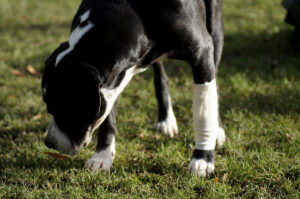
Pantarsal arthrodesis is a surgery for dogs that require a permanent solution for a damaged ankle joint.
Dogs, like humans, are susceptible to various injuries and conditions that can affect their mobility and quality of life. One such injury is a severe ankle (tarsal) injury, which can be debilitating for a dog. These injuries can cause pain, lameness, and impaired movement. When conservative treatments such as rest, medications, or physical therapy do not suffice, pantarsal arthrodesis—a surgical procedure to fuse the ankle joint—may be the best option for restoring function and alleviating pain.
What is Pantarsal Arthrodesis?
Pantarsal arthrodesis is a surgical procedure that involves the fusion of the bones within the tarsal (ankle) joint. The primary goal of this surgery is to eliminate movement in the ankle joint, thereby stabilizing it and reducing pain. This procedure is usually considered when the tarsal joint is severely damaged or unstable due to trauma, degenerative joint disease, severe arthritis, ligament injuries, or conditions such as immune-mediated polyarthritis.
Fusing the ankle joint stops the pain associated with joint movement by eliminating the joint space and creating a stable column of bone. While the dog will lose the natural range of motion in the ankle, the procedure is highly effective in improving overall limb function and enabling the dog to bear weight on the affected leg without discomfort.
Indications for Pantarsal Arthrodesis
Pantarsal arthrodesis is typically recommended for dogs with:
- Severe Trauma: Injuries such as fractures or dislocations of the tarsal bones, which are too severe to be managed with less invasive treatments, can necessitate this surgery.
- Chronic Instability: Dogs with chronic ligament injuries or ruptures, particularly of the calcaneal tendon, may benefit from fusion if the instability causes ongoing pain or lameness.
- Degenerative Joint Disease: Advanced arthritis that has not responded to conservative treatments can be a strong indication for this surgery, especially when it significantly impacts the dog’s quality of life.
- Failed Previous Surgeries: In some cases, dogs that have undergone previous surgical attempts to stabilize the tarsal joint but continue to experience pain or instability may require pantarsal arthrodesis as a definitive solution.
- Congenital Abnormalities: Some dogs are born with joint deformities that can lead to chronic pain or dysfunction in the ankle joint, making arthrodesis a viable corrective option.
Recovery and Post-Operative Care
Post-operative care is crucial to the success of pantarsal arthrodesis. Recovery can take several months, and during this time, strict activity restriction is necessary to ensure proper healing. Key aspects of post-operative care include:
- Pain Management: Medications will be prescribed to manage pain and inflammation. It is essential to follow the veterinarian’s dosage instructions carefully.
- Limited Activity: To prevent complications, such as hardware failure or delayed bone healing, the dog should be kept confined and only allowed controlled, minimal movement. This may involve crate rest or confinement to a small room.
- Physical Therapy: After the initial healing phase, physical therapy can be beneficial to help restore strength and mobility in the leg. A rehabilitation plan may include passive range of motion exercises, hydrotherapy, or other modalities as recommended by the veterinarian.
- Monitoring and Follow-Up: Regular follow-up visits with the veterinarian are necessary to monitor healing progress through physical exams and X-rays. Adjustments to the post-operative care plan may be made based on the dog’s progress.
- Bandage and Wound Care: Keeping the surgical site clean and dry is essential to prevent infection. Bandages should be checked and changed regularly as instructed by the veterinarian.
Please keep in mind that this is just a basic overview of common aspects of a recovery plan. Always listen to your veterinary surgeon and primary veterinarian when it comes to surgical aftercare, and ask questions if you’re ever unsure about something. Your plan is tailored to your dog and their needs, so it’s important that you understand it.
Prognosis and Outcome
The prognosis for dogs undergoing pantarsal arthrodesis is generally good, with many dogs returning to a pain-free and functional lifestyle post-surgery. However, it is important to understand that while the dog will lose natural movement in the ankle, they will still be able to walk, run, and play with the fused joint. Most dogs adapt well to this change in mobility, especially when the pain relief and improved stability significantly enhance their overall comfort and quality of life.
Trust Maryland Veterinary Surgical Services With Your Companion’s Health
Your companion’s health is important, and the team at MVSS is ready to provide the best care possible for your furry family. We are dedicated to combining comprehensive exams and assessments with informative and honest discussions of your companion’s care. Once we have worked with you to decide on the best course of action for your dog, our professionals will use their surgical expertise to work towards the goal of giving your companion an active and pain-free life. We are proud to serve loyal companions in Catonsville and Baltimore. To learn more about our services, give us a call at 410-788-4088 or visit us online. For more information and tips for dog health, follow us on Facebook and Pinterest.
